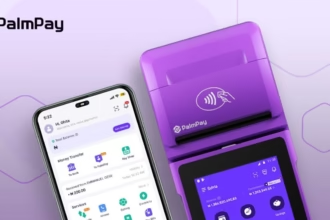PalmPay in talks to raise up to $100M in a fresh Series B funding round, in a bold move signalling its next phase of growth.
This development comes as no surprise to those who have watched the fintech space in Africa evolve over the last few years.
With profitability now achieved, a growing user base of 35 million, and over 15 million daily transactions, PalmPay is positioning itself as not just a local leader but a continental contender in Africa’s digital finance race.
What Is Driving the Fundraising?
PalmPay in talks to raise up to $100M is a reflection of confidence in its business model and profitability. Unlike many fintechs still burning through capital, PalmPay has already turned the corner into profitability.
The company has raised nearly $140 million in previous rounds, backed by tech heavyweights like Transsion and MediaTek.
Now, PalmPay is seeking up to $100M to accelerate its expansion across Africa and Asia. Its model, which blends digital banking with an on-the-ground agent network, has proven incredibly effective in markets where traditional banks struggle to reach informal and underbanked populations.
Expansion Plans: Beyond Nigeria
PalmPay in talks to raise up to $100M is closely tied to its ambitious plans to scale.
The company is eyeing deeper penetration in Nigeria, while also expanding to new African markets like South Africa, Tanzania, Côte d’Ivoire, and Uganda.
PalmPay has already launched operations in Ghana and Kenya, and even ventured into Bangladesh, its first non-African market.
The goal is simple: become the dominant digital finance platform in emerging markets. With funding from this upcoming Series B round, PalmPay intends to roll out services like device financing, mobile credit, and business-focused tools in these new territories.
A Hybrid Fintech Model That Works
One of the reasons PalmPay in talks to raise up to $100M matters is the company’s unique hybrid model. While most fintechs rely solely on app downloads, PalmPay also invests in physical infrastructure. It has built an agent network of over 1 million merchants and small businesses, providing in-person financial services to customers who may lack smartphones or stable internet.
This approach has paid off: more than 25% of users report that PalmPay was their first-ever financial account. For borrowers using credit products, that number jumps to 60%. It’s clear PalmPay is doing more than moving money. It’s onboarding entire communities into the formal financial system.
Profitability and Competitive Edge
Why does PalmPay in talks to raise up to $100M stand out?
PalmPay is one of the few profitable fintechs at its scale. In 2023, the company reported $64 million in revenue, and sources say that number has doubled in the last year. With 15 million daily transactions and “tens of billions” in annual transaction value, the company is operating at a scale that even traditional banks envy.
This gives PalmPay a huge advantage over rivals like OPay, Moniepoint, and FairMoney. While many competitors are still focused on acquiring users, PalmPay is focused on deepening relationships and increasing user lifetime value.
Also Read: What Every Nigerian Entrepreneur Gets Wrong About Social Media Marketing
Business Solutions and B2B Play
Another reason PalmPay in talks to raise up to $100M is drawing attention is the company’s growing focus on B2B.
Through PalmPay Business, merchants can accept cross-border payments via a unified API. This new functionality is already live in Nigeria, Kenya, and Tanzania, with South Africa next on the list.
This product taps into a real need: seamless payments across African borders. Businesses want solutions that work without the complexity of stablecoins, banking red tape, or infrastructure limitations. PalmPay is aiming to be that solution.
Strategic Investor Backing
PalmPay in talks to raise up to $100M also signals strong backing from strategic investors. Transsion, whose Tecno and Infinix smartphones dominate Africa, is a key partner. The PalmPay app is pre-installed on many Transsion devices, giving it a built-in advantage for user acquisition.
Other backers include MediaTek and GIC, Singapore’s sovereign wealth fund. With such strategic muscle, PalmPay is not just raising money; it’s aligning with stakeholders that can help it win in markets beyond Nigeria.
What It Means for Nigeria’s Fintech Ecosystem
PalmPay in talks to raise up to $100M is not just about one company’s growth. It’s a signal to the broader fintech ecosystem in Nigeria. For local startups, it proves that profitability is possible.
For investors, it shows that African fintech can scale and deliver returns. For regulators, it stresses the importance of enabling environments that support innovation.
As PalmPay prepares to enter new markets, it raises the bar for the entire ecosystem. It forces other players to innovate, cut costs, and deliver real value to customers. Ultimately, that’s good for everyone.
Challenges Ahead
Of course, PalmPay in talks to raise up to $100M doesn’t mean it’s all smooth sailing. The company will need to manage regulatory challenges, competitive threats, and the operational complexities of scaling across diverse markets.
Moreover, replicating its Nigerian success in other countries will depend on how well it localises products, builds partnerships, and manages cultural differences. The fintech space is fast-moving, and even leaders can fall behind if they fail to adapt.
Don’t Miss: How to Identify Your Business Competitors (Even If You’re Just Starting Out)
Final Thoughts
From its humble beginnings in 2019 to becoming one of the continent’s largest digital finance platforms, PalmPay has shown what’s possible with the right mix of vision, execution, and partnerships.
Whether this Series B round closes at $50M or hits the full $100M, one thing is clear: PalmPay is no longer a startup trying to find its footing. It’s a market leader with the ambition to shape the future of finance in Africa and beyond.






